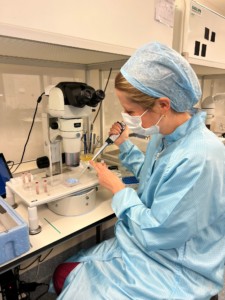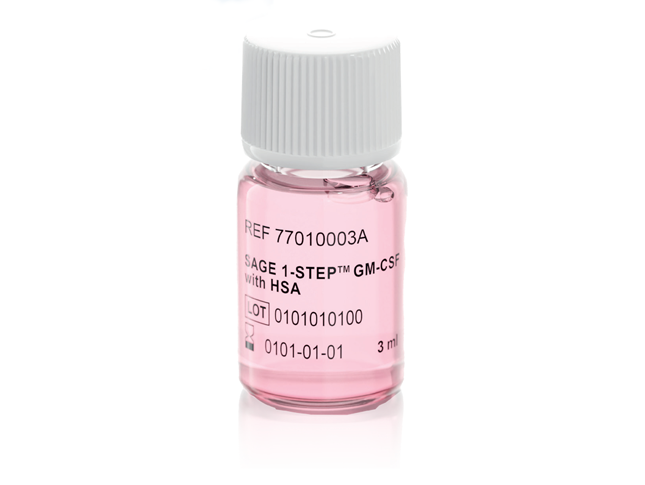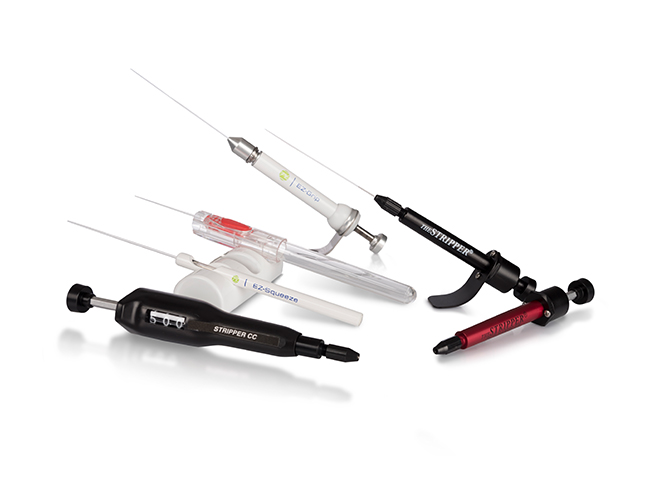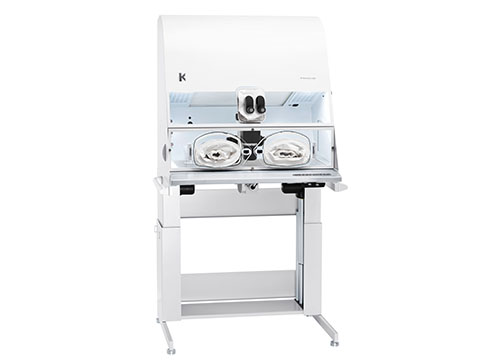An interview with Stacy Macpherson, Clinical Application Scientist for UK and Ireland, CooperSurgical
Cryoprotectants play a significant role in the vitrification process. We spoke with Stacy Macpherson, Clinical Application Scientist at CooperSurgical about current evidence on cryoprotectants and how embryologists can add to their knowledge base to help support clinical practice and continue to develop successful vitrification protocols.
Why are cryoprotectants so important in the process of vitrification?
Cryoprotectants or cryoprotective agents (CPAs) are critical when it comes to vitrification and warming. Put simply, they dehydrate and rehydrate oocytes, and embryos during the vitrification and warming processes.
Vitrification is a cryopreservation process where dehydration of cells takes place. A combination of intracellular cryoprotectants and extracellular cryoprotectants at relatively high concentrations draws water out of the cells and allows CPAs to move into the cells and replace the water.
In the warming process only extracellular CPAs, such as sucrose or trehalose, are used. Extracellular CPAs cannot penetrate cell membranes; instead, they form an osmotic gradient to draw intracellular CPAs out of the cells and allow water to move back into the cells. This process sees rehydration of the cells.1
“… [for embryologists] I think it is really important to understand the composition of the kit being used in your laboratory.”
In your daily clinical practice, do you think about the cryoprotectants you are using? If yes, how?
This is a really good question. I think when embryologists and laboratories are investigating different kits, it is definitely something they would look at. The lab will evaluate any new kit to ensure the kit’s results are in line with what they are currently using.
A vitrification kit usually contains two media vials that are used sequentially to vitrify oocytes, embryos, or blastocysts. The warming kit usually contains three media vials that are used sequentially to warm vitrified oocytes, embryos or blastocysts. The basic components within the media are CPAs, buffer (HEPES and/or MOPS) and protein (commonly HSA or HPC).
All solutions in the vitrification and warming kits tend to be made up of the same basic composition, the main difference between the solutions within the kit is the type and concentration of CPAs. 6
Vitrification solutions
Generally, vitrification kits contain two main solutions, an equilibration solution and a vitrification solution. The equilibration solution normally contains two types of intracellular CPAs at a concentration of around 15%. Common combinations include EG/DMSO or EG/PROH.
Warming solutions
Generally, warming kits contain three main solutions, a warming solution, a dilution solution, and a washing solution. Only the warming and dilution solutions contain cryoprotectant. Only extracellular CPAs are present, usually in the form of sucrose or trehalose. The warming solution tends to contain 1M sucrose or trehalose and the dilution solution tends to contain 0.5M sucrose or trehalose. This leads to gradual rehydration of cells. The washing solution does not contain cryoprotectant; its purpose is to allow recovery from the warming procedure before the oocytes or embryos are placed into culture. It also helps to remove cryoprotectants that may be present in the surrounding media to prevent carry over into the culture dish.
When working in the lab, it might not be that every embryologist knows what CPAs are in their vitrification and warming kits. Embryologists are vitrifying day in, day out and get into a habit of doing what they know best; following their standard operating procedure (SOP) because they know it works. Having said that, I think it is really important to understand the composition of the kit being used in your laboratory.

“Any kit can give you those high success rates that we’re all aiming for…So, we need to ensure that we are using the media within the guidelines that are set by the manufacturer.”
How does the cryo media used affect the clinical practice?
There are a lot of kits on the market, and they contain different combinations of intracellular CPAs such as DMSO, ethylene glycol, propanediol and extracellular CPAs, which are the sugars, sucrose and trehalose. When it comes to choosing a kit, there’s no evidence in favor of any particular kit.2 Any kit can be used well and optimized in any laboratory.
Any kit can give you those high success rates that we’re all aiming for and consequently, the way we use the kit can influence the outcomes for our patients. So, we need to ensure that we are using the media within the guidelines that are set by the manufacturer. This means adhering to strict volumes, temperatures, and timings, for example, as all of these parameters can impact outcomes.
For me, it’s more about the way you use the kit, rather than the kit itself.
How do cryoprotectants affect the choice of cryopreservation media?
Some kits have gained traction and some kits are more popular because they are well utilized and established. There’s lots of literature using specific types of kits and, therefore, a wealth of scientific data to back up using those particular kits. As scientists, this makes us say, ok there is a lot of data behind this kit, let’s use that one.
But when we step back and look at the actual biology behind how cryoprotectants work and the evidence base comparing the different kits, there’s no particular evidence in favor of a kit.3
A common question we often get asked is whether to use a DMSO or non-DMSO based kit. The evidence base demonstrates there is no clear advantage of either system.4 This was further endorsed last year by the Practice Committees of the American Society for Reproductive Medicine and Society of Reproductive Biologists and Technologists who stated that they are “separate and different systems…when done properly, both systems have very good results.”2
“There’s no evidence in favor of a particular CPA combination and that includes the sugars. They’re very similar in terms of their structure, they do the same job…”
Why do you think there is misinformation around cryoprotectants, particularly sucrose and trehalose?
Sugars come up a lot, which one is best? Trehalose or Sucrose?
As previously mentioned, there’s no evidence in favor of a particular CPA combination and that includes the sugars. They’re very similar in terms of their structure, they do the same job and it’s important to remember they’re extracellular CPAs, so they don’t penetrate the cell membranes. A study published a few years ago, compared two kits in oocyte donation cycles, one kit contained sucrose and the other contained trehalose. The study found no difference in the clinical outcomes for the egg donation cycle patients.5
Steven Fleming’s recent white paper delves deeper into CPAs and the recent evidence. 6

Is that why Steven Fleming’s white paper can be helpful for embryologists?
Yes. It’s not easy to find such a comprehensive summary on one particular topic, making it an interesting read for embryologists and lab managers.6
A lot of embryology labs are very busy, making it hard for embryologists to take the time to read new publications. Embryologists don’t have a lot of time to step back and read papers and review their processes when they’re in the lab every day treating patients.
I highly recommend Steven Fleming’s white paper. As a summary of CPAs including recent evidence, it is great for trainees and a nice refresher for experienced embryologists. Written in a clear and concise way, just a couple of pages, it’s just perfect. For embryologists, it helps us keep our knowledge base where it should be and keeps us thinking outside of routine laboratory practice. I think it’s a great paper and I hope everyone gets a chance to read it.
References:
- Elliott, GD et al. Cryoprotectants: A review of the actions and applications of cryoprotective solutes that modulate cell recovery from ultra-low temperatures. Cryobiology. 2017; 76: 74-91.
- Practice Committees of the American Society for Reproductive Medicine and Society of Reproductive Biologists and Technologists. A review of best practices of rapid-cooling vitrification for oocytes and embryos: a committee opinion. Fertil Steril. 2021;115(2):305-310.
- Parmegiani L. et al. Testing the efficacy and efficiency of a single “universal warming protocol” for vitrified human embryos: prospective randomized controlled trial and retrospective longitudinal cohort stud. J Assis Reprod and Genet. 2018;35:1887–1895.
- Pujol A. et al. Comparison of two different oocyte vitrification methods: a prospective, paired study on the same genetic background and stimulation protocol. Human Reproduction. 2019;34(6):989-97.
- Coello A. et al. A combination of hydroxypropyl cellulose and trehalose as supplementation for vitrification of human oocytes: a retrospective cohort study. J Assist Reprod Genet. 2016;33(3):413-21.
- Fleming S. Cryoprotectants. CooperSurgical White Paper May 2022.










